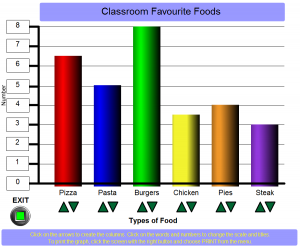Subject: Digital Technologies
Year Level: 3-4
Strand: Digital Technologies processes and production skills
Sub strand: Managing and analysing data
4.3 Collect, access and present different types of family, classroom and community data using simple spreadsheets, databases and other software to create information and solve problems.
Link to the resource
http://www.amblesideprimary.com/ambleweb/mentalmaths/grapher.html
Cross curriculum priorities and general capabilities
Numeracy
Information and communication technology capability
Critical and creative thinking
Links to other learning areas
Mathematics – Data Representation and Interpretation
Collect data, organise into categories and create displays using lists, tables, picture graphs and simple column graphs, with and without the use of digital technologies (ACMSP069)
Construct suitable data displays, with and without the use of digital technologies, from given or collected data. Include tables, column graphs and picture graphs where one picture can represent many data values (ACMSP096)
A classroom activity using this resource
Conduct a survey in the class on the topic of favourite foods. Record the data in a table on the interactive whiteboard. Students could then graph this data using the Grapher website.
How to use this resource
This website is extremely easy to use and child friendly. The title, x axis, categories and numbers can all be edited and adjusted to match the topic by simply clicking and typing. Once the graph has the desired fields of information, simply click on the arrows to increase the level of the column for each category to the correct number. These pages can then be printed out by right clicking on the screen, or refresh the page and you can start again. This is a great way of introducing graphing on computers for Year 3-4.


